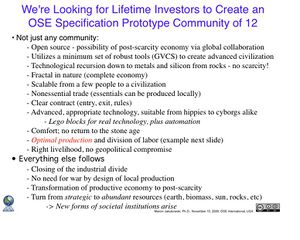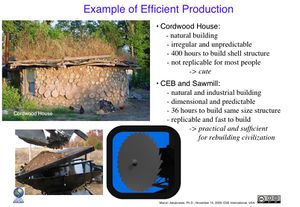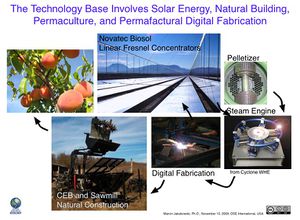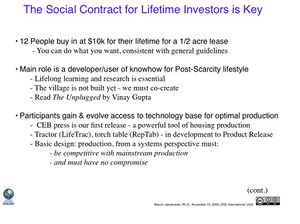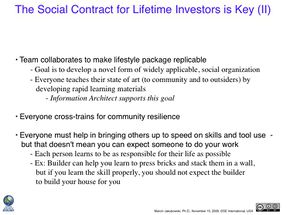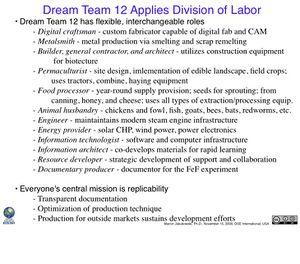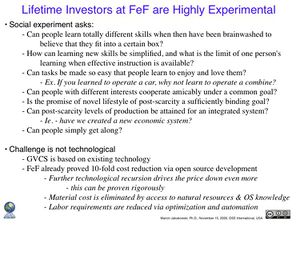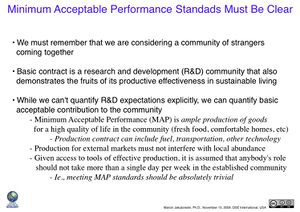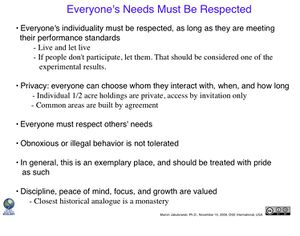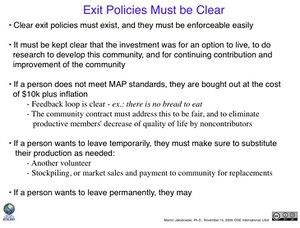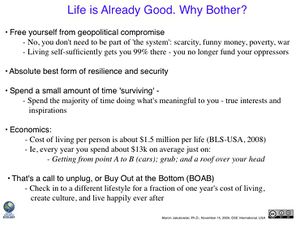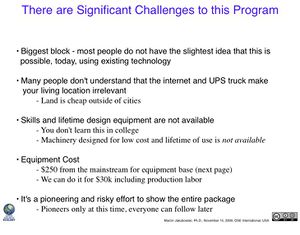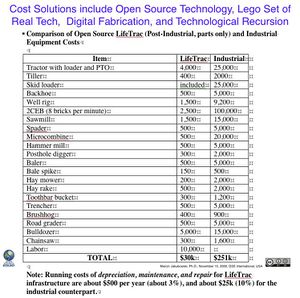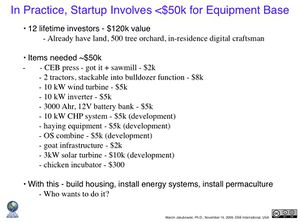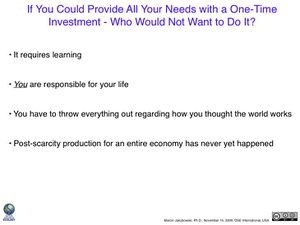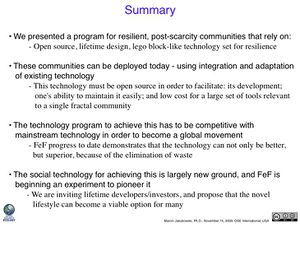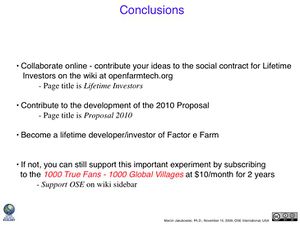Lifetime Investors: Difference between revisions
| Line 234: | Line 234: | ||
Comments: | Comments: | ||
Big round thousand numbers are nice but you'll have to break up those costs or reference where those costs are broken up better. Also, stop using optimistic numbers when you can't guarantee them! Its insulting and dishonest. Transparency and openness only please. | |||
| Line 241: | Line 242: | ||
. | |||
=Slide 33= | =Slide 33= | ||
[[Image:FSCONS33.jpg|thumb]] | [[Image:FSCONS33.jpg|thumb]] | ||
Revision as of 05:09, 20 November 2009
Introduction
Read about the Lifetime Investors program in the FSCONS 2009 Slides. The description of the program starts in Slide 19. Below, we take slides 19-35, and open them up for review, comments, and suggestions. We are focusing on how the social contract can be designed to create a workable, practical, post-scarcity, resilient community.
The slides below are listed individually, in order. Next to each slide is a description of its content with the space below left for comments. Each slide is up for comments.
Slide 19
We move on to the social technology, which is the real challenge of such a community. We accept that there are limits to how far a single family unit can reach in terms of post-scarcity, integrated economic existence. So we learn from history, and organize villages.
We have an ambitious program in mind, and the community that we're interested in creating is not just any ordinary community. We are looking for people dedicated to create the world's first, replicable, post-scarcity village. There are several unique features.
- Open source - only by global collaboration and winnowing and sifting of what works and what doesn't can we come up with a robust technological and social design.
- We utilize a minimum set of tools - not too large - because then we could not manage/develop/opensource these tools as easily. So we limit ourselves to a wise, sufficient set of choices - but, choices that can still lead to advanced civilization.
- We master our technology base. That means we can produce the necessary technologies locally. This mean that with time, we will apply technological recursion - the substitution of our skill and labor for outside sourcing. This mean - we begin making components, and eventually begin to make the actual feedstocks that make these components. Everything comes from the earth - rocks give you metals and computers.
- We are interested in a complete economy. This means, the village is fractal by design - it is complete in itself, or it can scale to multiple units that form cities and regions. They are resilient because they utilize their local resources. To utilize local resources, technological mastery is a prerequisite.
- The participation contract for the village must be clear. It's a research and development community - entry, exit, policy. This is not just a bunch of hippies in the woods running around with knives and polyethylene.
- Advanced appropriate technology is key. We are not talking about going back to the stone age. We can have all the trappings of modernity, but we can do it ecologically. This could be attractive to back-to-the-landers and technophiles alike. We are building adaptable, lego-block-like technology pieces, and automating production wherever desirable.
- A critical feature is optimal production. We must be able to provide needs efficiently - and this is the point that most hippy-in-the woods efforts are missing. This requires discipline and division of labor.
- There's a huge ethical point to this. There is no need for geopolitical compromise of killing and stealing from one another, leaving hordes of people deprived while a few at the top exist in a search for meaning.
From this design, everything follows. We close the industrial divide between the North and South - as technological advancement can be shared readily via the internet. There is no need for war because production is local. Strategic resources exist no more - as appropriate technology is able to generate needed services from abundant resources of earth, biomass, sun, rocks, etc. We are talking of no less than post-scarcity, new forms of societal organization, and all the tools necessary to get there are now in existence in the digital age.
Comments:
There is a huge discontinuity where the societal structure is barely mentioned. This should be the main focus of this topic as if these are lifetime investors, then they can't be just pawns to be tossed away when something doesn't work out, these are people who have a stake in the success of this venture. Restating the FeF purpose statement doesn't address this, and is better described other places in the site. Make reference to it with a link and get to the meat of what your doing, which is setting up a research and development community.
.
Slide 20
One important point is efficient production. Allow me to demonstrate. We built this cordwood building with 400 human hours of labor for a shell structure without furnishing. This was arduous, irregular, unpredictable. This is not efficient from the replicability standpoint. It is cute.
That's why the CEB Press and Sawmill are parts of the GVCS. See CEB Story for more details. The point is, the CEB and sawmill are efficient, natural, dimensional, and industrial. They are easy to build with, so you need about 10 times less time to build a similar structure. This is practical and sufficient for rebuilding civilization, if that is our goal. The CEB we have, we will be building the sawmill in February.
Comments:
A CEB press doesn't equate to instant housing. It's a tool. Talk about the plan you have for housing and how CEB and a saw mill fit into that plan.
.
Slide 21
The technology plan includes the standard cast of characters: building infrastructure, solar enregy, permaculture, digital fabrication, fuels and steam power.I won't get into the details, except make a few points. Solar linear fresnel design - seen in the picture, as done by Novatec Biosol, is proven - and we want to scale it down to home and village size of about 3kW and up. We believe we can do that if we have access to an open source, modern steam engine - and we propose the Steam Engine Construction Set. Combined with tractor -> hay bales -> pelletizer - we can fuel the steam engine with biomass pellets or the sun - for a combined heat and power (CHP) system. We can then power digital fabrication, to build more tractors and solar power systems, and the tractors can help us grow food. It's not that complicated.
Comments: It's not that complicated, but you'll need a plan. This is a good place to talk about energy infrastructure and how much it is going to cost to build such a thing. Experiences with personal energy budgets, and a realistic and CONSERVATIVE energy usage scenario would also be appropriate here.
.
Slide 22
The social technology is more complicated, because we need to get a number of diverse people to get along.
The basic program is that you buy in, now we're considering $10k a pop - for a 1/2 acre lifetime lease at FeF. You are free to do what you want with your share.
The contract is that you agree to participate actively in developing and improving the design and infrastructure of a replicable, post-scarcity community. This means a lifestyle of research and lifelong learning, where you must recognize that the village is not built yet. Think of it as a clear slate. And read The Unplugged by Vinay Gupta to see a fictional account quite similar to what we're proposing.
The role of the participants is to not only fund necessary developments through their acceptance fee, but to do development work - to create an infrastructure competitive with and superior to mainstream infrastructures. We do this simply by repackaging existing knowhow in the open framework of open source design. We can do this without compromising any human values, by taming technology towards true human service.
Comments:
Why $10k? Previously it was $5k. Also, when you consider that your paying for the privilege of renting a half acre of undeveloped land that will have no running water, no electricity, no internet, and no mailing address you'll have to do a bit better in laying out how that money will be used. I also want an expectation of other costs based on how much it will require to get the above basic living conditions. Most importantly, I want complete full disclosure of finances for this community for all revenue sources.
.
Slide 23
The team collaborates to make the entire package of lifestyle replicable - to those following these footsteps. While the development team must have pioneering skills, many can follow once the package is created.
Comments:
I like this.
.
Slide 24
Comments:
You desperately need a mechanical engineer, architect, , or someone well versed in structural engineering. Your building houses and a community here and you don't what them to fall down.
.
Slide 25
Comments:
I disagree that society building is highly experimental. The United States alone has over two hundred years of documented experimental communities and societies. Going into this without doing the proper research is irresponsible. If a company with over a million employees can keep them semi-honest, on task, happy and productive doing boring work, then you should be able to do 10x better.
.
Slide 26
Comments:
This is good but you need to also talk about leadership structure. I understand that Marcin will most likely take a figure head position due to his contributions, but we will need an effective village/community leader with experience managing and mediating people and problems.
.
Slide 27
Comments:
Some people actually like living close together. I believe that you could attract a more diverse group by allowing people to "go in" on a 1/2 acre so they can build something more like a villa with shared common space. Otherwise you would end up with a village of hermits or at best an extension of urban sprawl.
.
Slide 28
Comments:
You need entry procedures as well. You also need to be explicit about who has the power to determine when it is time to force someone to exit the premise. Otherwise, good.
.
Slide 29
Comments:
In Oklahoma right now, it would take roughly a year to two years to meet the $10k buy-in period for an individual making $20k-30k a year who has medical, housing, food, and personal expenses. You need to characterize the candidates a bit better. What about people with a wife and kids? What about someone who is retired and looking for something new? Think about where someone needs to be in life to make a contribution.
.
Slide 30
Comments:
This list needs to be better organized and expanded. You want to scare the ever living crap out of everyone who sees this stuff and if they are still ok with it, then talk to them. The other parts of this site should be enough to get people initially interested.
.
Slide 31
Comments:
Again, cost of infrastructure is only a small part in the total cost of constructing a community.
.
Slide 32
Comments:
Big round thousand numbers are nice but you'll have to break up those costs or reference where those costs are broken up better. Also, stop using optimistic numbers when you can't guarantee them! Its insulting and dishonest. Transparency and openness only please.
.
Slide 33
Comments:
.
Slide 34
Comments:
.
Slide 35
Comments:
.
